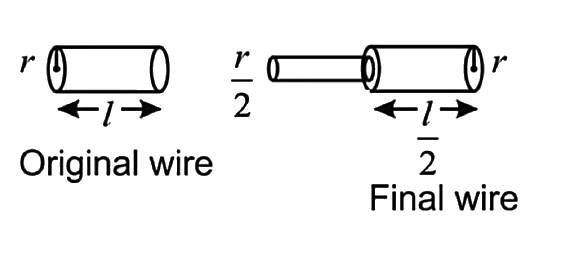A copper wire of length l and radius r is nickel plated till its final radius is 2r. If the resistivity of the copper and nickel are ρc and ρn, then find the equivalent resistance of the wire.
The correct Answer is:2m/s
To find the equivalent resistance of a copper wire that has been nickel plated, we can follow these steps:
Step 1: Calculate the Resistance of the Copper Wire
The resistance Rc of the copper wire can be calculated using the formula:
Rc=ρc⋅lAc
where:
- ρc is the resistivity of copper,
- l is the length of the wire,
- Ac is the cross-sectional area of the copper wire.
The cross-sectional area Ac of the copper wire with radius r is given by:
Ac=πr2
Thus, the resistance of the copper wire becomes:
Rc=ρc⋅lπr2
Step 2: Calculate the Resistance of the Nickel Plated Section
The nickel plating increases the radius to 2r. The resistance Rn of the nickel section can be calculated similarly:
Rn=ρn⋅lAn
where:
- ρn is the resistivity of nickel,
- An is the cross-sectional area of the nickel plated wire.
The cross-sectional area An of the nickel section with radius 2r is:
An=π(2r)2=π⋅4r2
Thus, the resistance of the nickel section becomes:
Rn=ρn⋅lπ⋅4r2
Step 3: Combine the Resistances in Parallel
Since the copper wire and the nickel plated section are in parallel, the equivalent resistance Req can be calculated using the formula for resistances in parallel:
1Req=1Rc+1Rn
Substituting the expressions for Rc and Rn:
1Req=πr2ρc⋅l+π⋅4r2ρn⋅l
Factoring out common terms:
1Req=1l(πr2ρc+4πr2ρn)
1Req=πr2l(1ρc+4ρn)
Step 4: Solve for Req
Taking the reciprocal to find Req:
Req=lπr2⋅1(1ρc+4ρn)
This can be simplified further:
Req=l⋅ρc⋅ρnπr2(ρn+4ρc)
Final Result
The equivalent resistance of the wire is:
Req=ρc⋅ρn⋅lπr2(ρn+4ρc)
The resistance Rc of the copper wire can be calculated using the formula:
Rc=ρc⋅lAc
where:
- ρc is the resistivity of copper,
- l is the length of the wire,
- Ac is the cross-sectional area of the copper wire.
Ac=πr2
Thus, the resistance of the copper wire becomes:
Rc=ρc⋅lπr2
The nickel plating increases the radius to 2r. The resistance Rn of the nickel section can be calculated similarly:
Rn=ρn⋅lAn
where:
- ρn is the resistivity of nickel,
- An is the cross-sectional area of the nickel plated wire.
An=π(2r)2=π⋅4r2
Thus, the resistance of the nickel section becomes:
Rn=ρn⋅lπ⋅4r2
Since the copper wire and the nickel plated section are in parallel, the equivalent resistance Req can be calculated using the formula for resistances in parallel:
1Req=1Rc+1Rn
Substituting the expressions for Rc and Rn:
1Req=πr2ρc⋅l+π⋅4r2ρn⋅l
Factoring out common terms:
1Req=1l(πr2ρc+4πr2ρn)
1Req=πr2l(1ρc+4ρn)
Taking the reciprocal to find Req:
Req=lπr2⋅1(1ρc+4ρn)
This can be simplified further:
Req=l⋅ρc⋅ρnπr2(ρn+4ρc)
The equivalent resistance of the wire is:
Req=ρc⋅ρn⋅lπr2(ρn+4ρc)
Topper's Solved these Questions
- CURRENT ELECTRICITYBOOK - ALLENCHAPTER - CURRENT ELECTRICITYEXERCISE - EXERCISE-III
26 Videos
- CURRENT ELECTRICITYBOOK - ALLENCHAPTER - CURRENT ELECTRICITYEXERCISE - EXERCISE-IV A
32 Videos
- CIRCULAR MOTIONBOOK - ALLENCHAPTER - CIRCULAR MOTIONEXERCISE - EXERCISE (J-A)
6 Videos
- GEOMETRICAL OPTICSBOOK - ALLENCHAPTER - GEOMETRICAL OPTICSEXERCISE - subjective
14 Videos
Similar Questions
Knowledge Check
Two copper wire of length l and 2l have radii, r and 2r respectively. What si the ratio of their specific resistance.?
A1:2B2:1C1:1D1:3One end of a horizontal thick copper wire of length 2L and radius 2R is welded to an end fo another horizontal thin copper wire of lenth L and radius R. When the arrangement is stretched by applying forces at two ends, the ratio of the elongation in the thin wire to that in the thick wire is
A0.25BÂ 0.50CÂ 2.00D4.00
Shown a conductor of length l having a circular cross section. The radius of cross section varies linearly form a→b. The resistivity of the material is(ρ).Assuming that b−a<<l,find the resistance of the conductor.

View SolutionA current i passes through a wire of length l , radius of cross-section r and resistivity ρ . The rate of heat generation is
View SolutionA wire of length l has a resistance R. If half of the length is stretched to make the radius half of its original value, then the final resistance of the wire is

View SolutionOne end of a horizontal thick copper wire of length 2L and radius 2R is weded to an end of another horizontal thin copper wire of length L and radius R .When the arrangement is stretched by applying forces at two ends , the ratio of the elongation in the thin wire to that in the thick wire is
View SolutionThe wires is of same dimension but resistivities ρ1 and ρ2 are connected in parallel . The equivalent resistivity of the combination is
View SolutionIf a wire is stretched to double its length, find the new resistance if the original resistance of the wire was R.
View Solution
